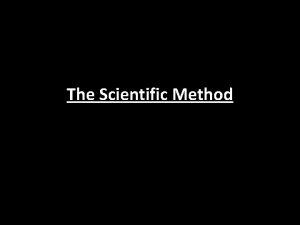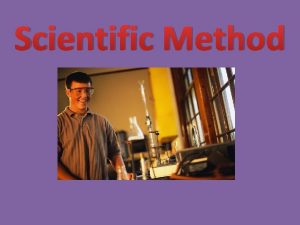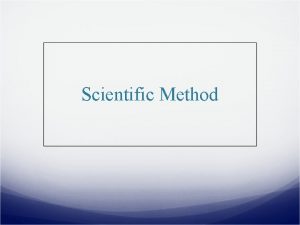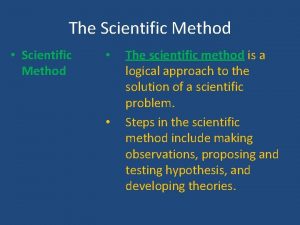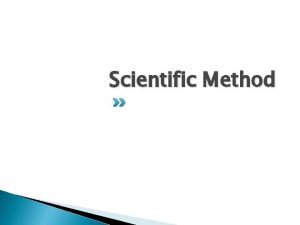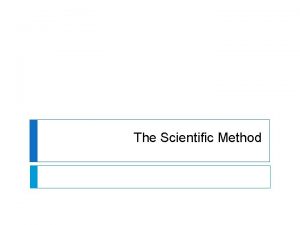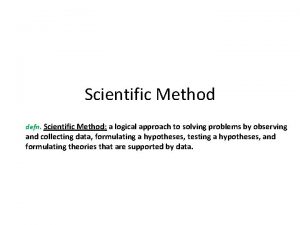Scientific Method The scientific method is a logical














- Slides: 14

Scientific Method

The scientific method is a logical, systematic approach to the solution of a scientific problem. 1. Make an observation A. Qualitative-use your senses B. Quantitative-make a measurement 2. Leads to a Question 3. Hypothesis-proposed explanation for an observation.

4. Perform an Experiment **Procedure designed to test 1 variable A. Manipulated/Independent variable: The variable that will be manipulated B. Observed/Dependent variable: The variable that will change depending on the independent variable. **In order for results to be accepted, anyone must be able to repeat experiment with the same results.

5. Analyze Results If results prove hypothesis, then develop a theory If results do not match, then return to step 3. (hypothesis)

Theory vs. Law Theory: well tested explanations for a broad set of observations. **Theories can never be proved-means that there is room for it to be changed. Law: Statement that summarizes many observations or experiments.

Theory or Law? 1. 2. 3. 4. 5. 6. Pressure is caused by particles moving very fast. Theory Atoms combine because of charged particles. Theory Compounds have a definite composition. Law Total mass is the same before and after a reaction. Law Light is caused by energy being Theory released in the form of waves. Heat flows from hot areas to cold areas. Law

Ms. G wants to find out which bug spray works best: Off, Avon, or Cutter. � What should be kept constant (the same) over the course of the experiment?

These are the results: � Group 1 � Group 2 � Group 3 � Group 4 (OFF): (Avon): (Cutter): (None): 4 mosquito bites 18 mosquito bites 10 mosquito bites 28 mosquito bites

� Which group was the control? ◦ Group 4 � What is the independent variable? (what did I change each time? ) ◦ Brand of Bug spray � What is the dependent variable? (what changed because of the type of spray used? ◦ Number of Mosquito bites � What should be her conclusion? ◦ OFF Brand is the most effective in reducing the number of mosquito bites.

Scenario #1: � You read in the paper that the number of dead tadpoles along the Yadkin River has increased over the past few years. Since you are an inquisitive teen you want to know why. After examining all of the data available in the library, you decide to go with a hypothesis that increased Ultraviolet (UV) radiation from the deterioration of the ozone is killing off the tadpoles.

1. How many steps in the scientific method have been accomplished? Identify them. A. B. C. Make an Observation-decreased number of tadpoles. Ask a Question-What is killing the tadpoles. Hypothesis-UV radiation from the hole in the ozone layer is killing off the tadpoles.

You design an experiment with two groups of tadpoles. Group 1 has 100 tadpoles in a 5 gallon drum of water covered by a piece of glass. You read at the library that glass filters out UV radiation so that none will reach the interior of the container. The second group is set up exactly like Group 1 except it has acrylic plexiglass, which will not filter UV radiation out. You place the groups outside for a month with a regular feeding schedule and then observe the results.

2. What is the independent variable and what is the dependent variable? Independentexposure to UV light 3. Dependent-number of tadpoles Which is the control group? Group 1 -no UV radiation 2. What is the difference between the two groups? Exposure to UV radiation 3. What other factors have you attempted to control with this experimental setup? Size of container, number of tadpoles, water, food, temperature, time of experiment

Initial number of tadpoles Final number of tadpoles Group 1 100 Group 2 100 96 95 6. Does the information from this experiment support the hypothesis? No-the data doesn’t show any change. 7. If no, then what might be causing a decrease in the tadpole population? What do you think? 8. Design an experiment to test your hypothesis. Partner up!
 P q logical equivalence
P q logical equivalence Kesetaraan logis adalah
Kesetaraan logis adalah Information gathered during an experiment
Information gathered during an experiment Hát kết hợp bộ gõ cơ thể
Hát kết hợp bộ gõ cơ thể Frameset trong html5
Frameset trong html5 Bổ thể
Bổ thể Tỉ lệ cơ thể trẻ em
Tỉ lệ cơ thể trẻ em Chó sói
Chó sói Tư thế worms-breton
Tư thế worms-breton Chúa yêu trần thế alleluia
Chúa yêu trần thế alleluia Các môn thể thao bắt đầu bằng tiếng bóng
Các môn thể thao bắt đầu bằng tiếng bóng Thế nào là hệ số cao nhất
Thế nào là hệ số cao nhất Các châu lục và đại dương trên thế giới
Các châu lục và đại dương trên thế giới Cong thức tính động năng
Cong thức tính động năng Trời xanh đây là của chúng ta thể thơ
Trời xanh đây là của chúng ta thể thơ


















